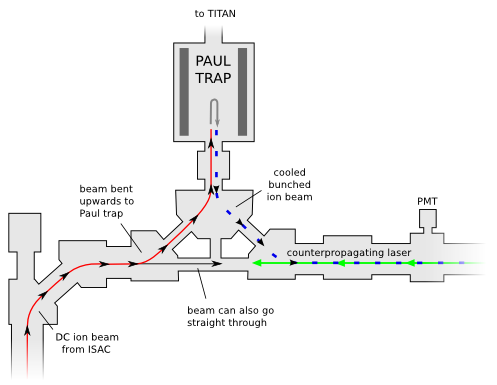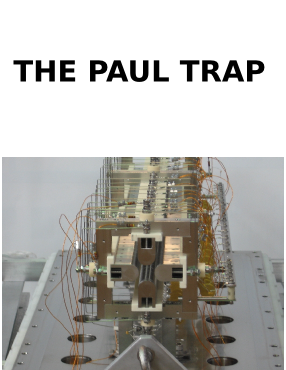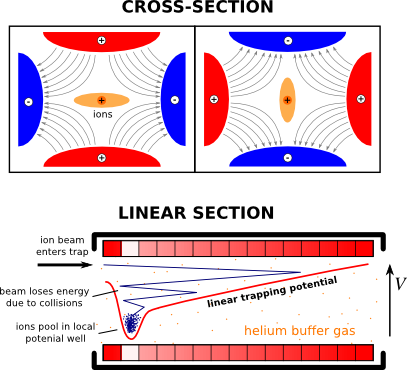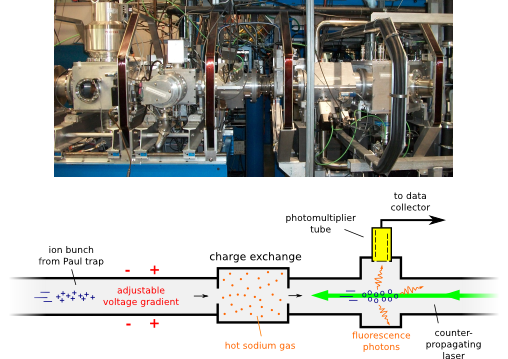The short-lived isotopes to be studied in the CFBS experiment are produced by TRIUMF's Isotope Separator and Accelerator (ISAC) facility. A prim ary proton beam of 500 MeV from TRIUMF's cyclotron is collided with a stationary target, producing exotic nuclei through spallation, fragmentation and fission reactions. These are extracted from the target by diffusion and are then ionized, accelerated and mass-separated to produce a beam of the ion of interest. Advanced ion-production techniques combined with the high beam intensity of TRIUMF's cyclotron uniquely enable ISAC to produce usable amounts of very rare isotopes which cannot normally be produced in sufficient quantity.
ary proton beam of 500 MeV from TRIUMF's cyclotron is collided with a stationary target, producing exotic nuclei through spallation, fragmentation and fission reactions. These are extracted from the target by diffusion and are then ionized, accelerated and mass-separated to produce a beam of the ion of interest. Advanced ion-production techniques combined with the high beam intensity of TRIUMF's cyclotron uniquely enable ISAC to produce usable amounts of very rare isotopes which cannot normally be produced in sufficient quantity.
The resulting ion beam is a DC beam, and to achieve greatest measurement sensitivity it must be converted into a pulsed, or “bunched” beam before it is spectrally analyzed. This is done by directing the beam into the Paul trap cooler and buncher used in TRIUMF's TITAN experiments. The Paul trap consists of a segmented linear arrangement of quadrupole electrodes, whose polarity is constantly being switched by a square radio-frequency signal. The net result of this high-frequency switching of the quadrupole field is that ions inside the trap are confined to an oscillatory motion along both axes of the quadrupole. The entire trap floats at a voltage just below the beam energy, so that the ion beam loses most of its velocity upon entering. Its segments are voltage-shifted by different DC voltages in such a way as to trap the ions in the axial direction as well. Helium or hydrogen gas fills the trap chamber, cooling the ion beam through collisions and damping out the ions' oscillatory motion (barring RFQ heating, which can occur within certain mass regimes) so that they come to rest in a local potential well. A potential “kick” from one of the quadrupole segments is used to reverse-extract the ions from the trap, resulting in a bunched beam with an energy spread of a few eV and a temporal length of ~1 μs. This experimental setup represents the first instance of a bunched ion beam being reverse-extracted from a linear Paul trap.


So bunched, the extracted ions accelerate ag ain to their beam-energy of roughly 30 keV, which further reduces the spread of their velocities. A minimal velocity spread is essential in order to avoid excess residual Doppler broadening of the ions' spectral peaks. The beam is deionized through charge-exchange with a hot sodium vapor, and then overlapped by the beam of a tunable laser (Ti:sapphire, dye, etc.) in collinear geometry so as to maximize the region of overlap. The laser frequency is locked throughout the experiment, and an adjustable voltage gradient is used to slightly decelerate the particle beam, Doppler-tuning it to resonance with the laser. A photomultiplier tube inside the beam-line records the fluorescence that results when an atom in the beam accepts a photon of laser light and subsequently decays from its excited state. By only accepting light signals whose timing coincides with the presence of an ion “bunch,” the background signal due to laser scattering and “dark counts” in the photomultiplier is greatly suppressed compared to a scheme using a DC beam. The gain in sensitivity is roughly equal to the ratio of the pulse duration to the time between pulses, which in this case corresponds to a noise-reduction by roughly four orders of magnitude.
ain to their beam-energy of roughly 30 keV, which further reduces the spread of their velocities. A minimal velocity spread is essential in order to avoid excess residual Doppler broadening of the ions' spectral peaks. The beam is deionized through charge-exchange with a hot sodium vapor, and then overlapped by the beam of a tunable laser (Ti:sapphire, dye, etc.) in collinear geometry so as to maximize the region of overlap. The laser frequency is locked throughout the experiment, and an adjustable voltage gradient is used to slightly decelerate the particle beam, Doppler-tuning it to resonance with the laser. A photomultiplier tube inside the beam-line records the fluorescence that results when an atom in the beam accepts a photon of laser light and subsequently decays from its excited state. By only accepting light signals whose timing coincides with the presence of an ion “bunch,” the background signal due to laser scattering and “dark counts” in the photomultiplier is greatly suppressed compared to a scheme using a DC beam. The gain in sensitivity is roughly equal to the ratio of the pulse duration to the time between pulses, which in this case corresponds to a noise-reduction by roughly four orders of magnitude.
![]()
Previous: Theory | Up |
